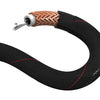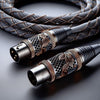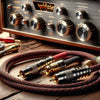The Art of Silence in Sound: Air Tube Dielectrics in Audio Cables

The Art of Silence in Sound: Air Tube Dielectrics in Audio Cables
In the nuanced world of high-fidelity audio, every detail matters, and the materials used in audio cables are no exception. Among these, dielectric materials are of paramount importance. A dielectric is an electrical insulator that can be polarized by an applied electric field. When a dielectric material is placed in an electric field, electric charges do not flow through the material as they do in an electrical conductor but only slightly shift from their average equilibrium positions causing dielectric polarization. This means that dielectric materials can store electrical energy, which is why they are commonly used in capacitors and, importantly, in audio cables.
The dielectric constant, or relative permittivity, is a measure of how much electric flux a material can hold compared to a vacuum. It’s a dimensionless number that represents the ratio of the permittivity of a substance to the permittivity of free space. The dielectric constant is crucial in audio cables because it affects the capacitance, signal speed, and frequency response of the cable. Lower dielectric constants are preferable for reducing signal loss and maintaining signal integrity.
Traditional dielectric materials used in audio cables include polyethylene (with a dielectric constant of approximately 2.3), polypropylene (around 2.2), and Teflon (around 2.1). However, AIR, with a dielectric constant of approximately 1.00059, is superior to all these materials. This is because air, being less dense, has a lower dielectric constant, which means it stores less energy and therefore has less potential for energy release that can distort the signal.
Air tube dielectric technology takes advantage of air’s low dielectric constant by minimizing the contact between the cable’s conductors and any solid material. In an air tube dielectric cable, the conductors are suspended in tubes filled with air, reducing the interaction with solid materials and thus lowering the overall dielectric constant of the cable. This design significantly reduces capacitance and signal loss, allowing for a purer transmission of the audio signal.
The (best to worst) values of dielectric constants for some common materials are as follows:
- Vacuum: 1.00
- Air: 1.00059
- Polyethylene: 2.3
- Polypropylene: 2.2
- Teflon: 2.1
- Glass: 3.8-14.5
- PVC: 4.0
These values illustrate why air tube dielectrics are superior; the closer the dielectric constant is to 1, the less impact the dielectric material has on the signal. By using air as the primary dielectric, air tube cables provide a near-perfect environment for signal transmission, free from the distortions that can be introduced by solid dielectric materials.
The dielectric material in an audio cable is a critical factor in the cable’s ability to transmit a clean, unaltered signal. Air tube dielectric cables represent the pinnacle of this technology, offering audiophiles and sound professionals the purest possible signal transmission. As the audio industry continues to innovate, air tube dielectrics stand out as a key technology for achieving the highest fidelity in sound reproduction.
See our Silver Serpent AIR RCA Cables an example of a cable using an air-tube dielectric.
-
Posted in
coductor, dielectric, rca cable












